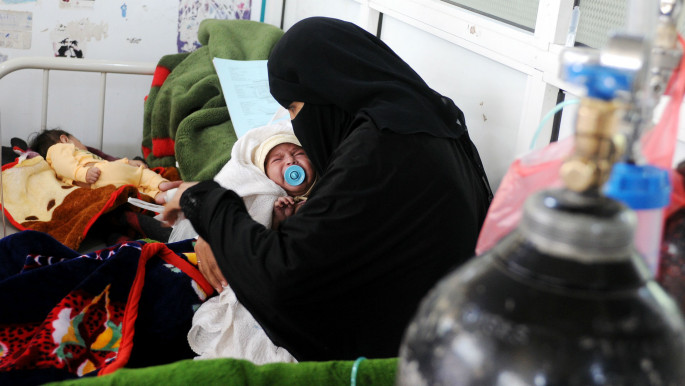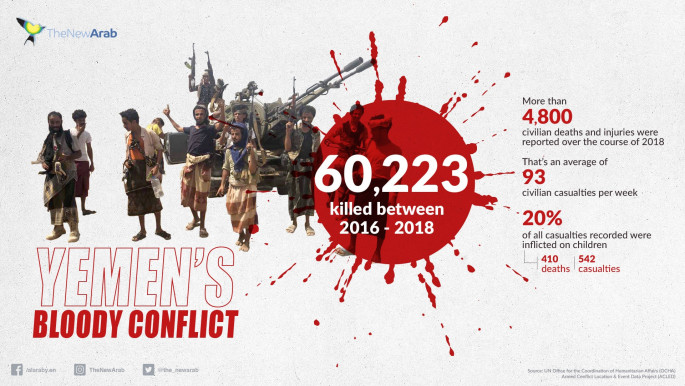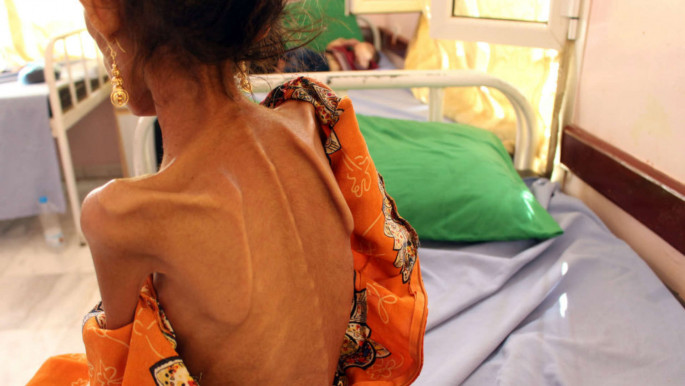Game of Thrones: Coalition-backed government militias battle it out in Yemen
"This is the Security Belt – our guys," my host, a commander of a pro-government militia group tells me. A few minutes drive along the coast of Abyan, we meet yet another checkpoint armed by young soldiers.
"And these guys?" I ask once again.
"This is the Popular Resistance Committee – our guys, they're all our guys," he replies.
After four years of a deadly and complicated conflict, I landed in my native Aden to what can only be described as unfamiliar scenes. Shabby checkpoints, an influx of young soldiers and more weapons than I had ever seen in the temporary capital.
In March 2015 and after overrunning the capital Sanaa, the Houthi rebels began to march south toward the coastal city of Aden, where the government of Abedrabbo Rabbo Mansour Hadi had sought refuge following what it called the rebel coup.
Almost immediately, resistance groups made of local young men and boys eager to defend their home city began to form. The young men, some who had never loaded a gun nor held a bullet between their fingers, quickly became acquainted with state-of-the-art weapons.
"Jabal Hadeed in Aden is a known government arms depot," M, a young soldier from pro-government forces told me.
 |
|
| Read also: Yemen in Focus: Tragedy strikes pregnant mothers and newborns |
"As soon as we heard of the incoming rebels, local men raided the mountain and all the military bases in the city and took what they needed to take," he said, referring to a mountain used as a storage for government weaponry in the Khormaksar district of Aden.
For nearly four months, government forces and local militias, backed by the Saudi and Emirati-led coalition, battled furiously side by side to fend off the Houthi rebels and loyalists of the former President Ali Abdullah Saleh.
"And now we are free of the invaders," the commander told me as we drove past the remnants of the war.
But despite the obvious destruction prevalent across the city, from its gateway to its cratered central peninsula, life continued as normal for the majority of its civilians, though many were becoming more and more disenfranchised with the increasing levels of militia groups occupying the city.
Though all armed factions stand against the Houthi rebel group, militia groups in the south of the country have become increasingly divided and have, on several occasions, locked heads and arms in battles across major cities, including Aden and Taiz.
 |
Despite standing alongside each other in the fight against the rebels, the militia groups have proven themselves incapable of coexisting. Each faction is willing eliminate the rival group in order to remain unchallenged and in control |  |
Last year, a bloody battle erupted between the armed factions, one of which loyal to the separatist Southern Transitional Council (STC) and backed by the Emiratis, while the other served Hadi's government and fell comfortably into Saudi hands.
This week, similar battles have taken place between forces loyal to the Hadi government in Yemen's third largest Taiz city, where the armed groups have taken their eyes off the Houthi enemy surrounding the city to challenge each other instead.
At least five people have been killed in nearly a week of clashes between Abu Al-Abbas and Islah [Muslim Brotherhood-backed] militias - both of which belong to pro-government militias that have been recently inaugurated as part of the army and security forces.
But the truth is, despite standing alongside each other in the fight against the rebels, the militia groups have proven themselves incapable of coexisting. Each faction is willing eliminate the rival group in order to remain unchallenged and in control, local journalist Fuad Rajeh told The New Arab.
"I believe president Hadi and the Saudi-led coalition are seeking to weaken both sides because they are not allowing the local authorities to do their job.
"The incompetent government can't control the forces under its own command and this is because it can't make decisions independently - the coalition has the decision of war in Yemen, Rajeh said.
 |
|
But coalition states, most notably Saudi Arabia and the United Arab Emirates, have had a face off in Yemen in a bid "to serve their own agendas at the expense of the country, and their actions are a proof of this," Rajeh said.
Concerns have been raised surrounding the UAE's intentions in the south of Yemen, where it has built a solid link of alliances and established control over major cities, especially Aden. The Emiratis boast several bases in the coastal city where the country's forces operate all military activity, including training local men-turned-soldiers.
If the coalition intends to fight off Iranian influence in Yemen, as was clearly stated in the lead up to the 2015 intervention, then why does it allow, and sometimes push militant factions under its control, to fight and wreak havoc, locals have questioned.
 |
The problem exposes disagreements between the government and some coalition states... despite the coalition's numerous attempts to project a united front against the Houthis in Yemen |  |
"The problem exposes disagreements between the government and some coalition states," he added, despite the coalition's numerous attempts to project a united front against the Houthis in Yemen.
However, the militias are anything but united, as 31-year-old M told me.
"Can you imagine? The Popular Resistance was called to battle at Aden airport so I got my gear, covered my face and went ready to fight. My gun was pointed and prepared to shoot a soldier from the Security Belt," M said, replicating the moves from that day.
"I stopped when I realised it was my own brother," he said as an expression of shock occupied his face. "We've achieved a lot in defending the city from the Houthis but this in-fighting is not what we signed up for," he added.
More than four years into the Saudi-Emirati war on the Houthi rebels in Yemen, recent figures by ACLED suggest that more than 70,000 have been killed since the coalition intervened to reinstate the government following the rebels' takeover of the capital.
The conflict has pushed millions of Yemenis to the brink of mass starvation but efforts to end the conflict for the country's 27 million population have so far failed to blossom.
 |
|
| Read also: Yemen: Where your worst nightmares have become reality |
In February, Amnesty International revealed weapons supplied by Western governments to the UAE in Yemen were being illicitly diverted to unaccountable militias fighting in the ongoing conflict.
"Emirati forces receive billions of dollars' worth of arms from Western states and others, only to siphon them off to militias in Yemen that answer to no-one and are known to be committing war crimes," said Patrick Wilcken, Arms Control and Human Rights Researcher at Amnesty International.
Other weapons used by the UAE-allied militias in Hodeida include Serbian-made Zastava MO2 Coyote machine guns and the Agrab armoured-truck-mounted Singaporean 120mm mortar system – the UAE is the only country known to purchase this combined weapon system.
Some of these militias are accused of war crimes and other serious violations, including during the recent offensive on the port city of Hodeida and in the UAE-backed network of secret prisons in southern Yemen.
But beyond the death and destruction, the coalition's recklessness in the south of the country, including its puppeteering of local militia groups to achieve its divided agendas could prove to have a serious impact on the authority of the internationally recognised government of Yemen for decades to come.
"All militias need to be disbanded and a national force, free of politicised forces and militias, must be instated. The coalition should not back forces and militias within the army because this is a big mistake," Rajeh added.
"The government of Yemen should wake up."
Sana Uqba is a journalist at The New Arab
Follow her on Twitter: @Sanasiino





 Follow the Middle East's top stories in English at The New Arab on Google News
Follow the Middle East's top stories in English at The New Arab on Google News


